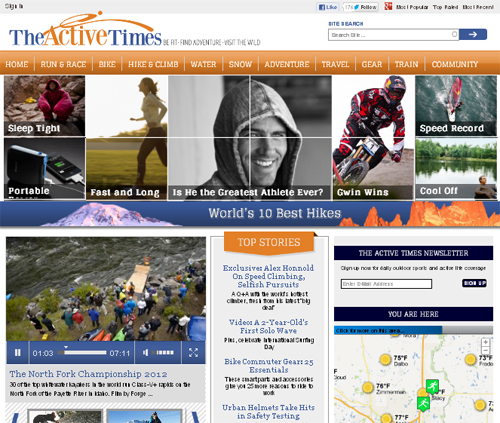Heads up, Outside magazine. National Geographic and GearJunkie, too. The former CEO of Forbes.com, Jim Spanfeller, has launched an outdoors/active-lifestyle publication, The Active Times, based in New York, which has a goal to publish 50 to 100 stories a day.
Yep, 50 to 100 articles each day on outdoors, travel, and “active” topics. By comparison, that quantity is more articles than many publications put out in an entire month. The effort, Spanfeller hopes, will quickly boost The Active Times, which launched last week, to a top spot in a category dominated by brand names that have been around for years.
Ambition is one thing not lacking in the company’s plan. “No one has excelled in this space,” Jim Spanfeller told me in a phone interview last week. “In digital, there are no big hub players, it’s all disparate content and it’s not well architected.”

A vast deluge of content targeted at a wide range of active people is the publication’s goal. (Official company mission: “The Active Times aims to be the world’s best source of authoritative, inspiring, enlightening content for living the active, adventurous life.”)
Spanfeller sees the current world of outdoor-related media as too narrow and caught in an old-school, print-publication-based mindset where niche subject matter rules.
“We want to be like Outside magazine, Bicycling, Backpacker, and VeloNews combined,” he said, making the point that The Active Times will strive to be “wide and deep” in its content stream.
Spanfeller said when he ran Forbes.com the publication was pumping out many thousands of articles a week. I am unsure what an “article” means under Spanfeller’s terms, as those figures seem simply unsustainable if we’re talking about anything representing quality journalism.
But the formula is not without a proven template in more niche subject matter. In early 2011, Spanfeller Media Group launched a food site, The Daily Meal, which follows the aforementioned “wide and deep” theme in its content strategy. It covers restaurants, recipes, chefs, food trends, and health topics, and it is ostensibly highly successful. The Daily Meal puts out more than 100 articles per day, Spanfeller said, and each month about 4 million people read the site.
The Active Times staff has similar goals. The site is currently publishing about 20 articles a day and looking to ramp up to the “50 to 100” per diem by the end of the year.

Leading the editorial effort is no newbie. Spanfeller hired John Rasmus to be editorial director of The Active Times. Rasmus is a veteran journalist and editor who has held high positions such as editor of Outside magazine and founding editor of National Geographic Adventure. A press release on the launch of The Active Times touts Rasmus as “the only editor in history to win the National Magazine Award for General Excellence at three separate publications.”
Journalism awards are not likely coming to The Active Times at any point soon. Overall, the site’s content is short and “web-friendly” kind of stuff that’s fun to browse but far from quality journalism. How-to’s like “Basic Surf Safety” and oddball stories including “A 2-Year-Old’s First Solo Wave” and “Beer: A Marathon Recovery Elixir?” dominate the main page.
However, last week I read a dozen or more stories and found myself entertained and happy to continue clicking around the site. There are videos posted from YouTube and syndicated content from the Competitor Group as well.
Rasmus has rounded up some good writers and a few longtime outdoor-journalism fixtures to contribute like David Roberts, Outside Magazine correspondent Tim Neville, famous long-distance hiker Andrew Skurka, among several others. But a bulk of the content for the site will come from unpaid contributors, not professional writers, Spanfeller said.
These unpaid “community contributors,” as the site calls them, are coaches, travel experts, and outdoor guides looking for publicity online. The model borrows from sites like Huffington Post, offering exposure as a currency instead of money.

One freelance writer for the site told me The Active Times “wants good journalism but is unwilling to pay for it,” noting the publication pays almost nothing to experienced writers and instead offers a bio page on the site. “You get $100 or $200 max for features,” the source said. “The sad thing is, that seems to be a viable business model. But out of respect for the profession and my own well being, I have to believe my work, training and effort has a price worth far more than that.”
Media and journalism has changed much in recent years. Pay is down for freelancers across the board, and The Active Times hardly invented the formula.
But with this “Huffington Post model” (dozens or hundreds of unpaid contributors) plus a content-blasting strategy not far from what’s seen at so-called “content mills” like Demand Media, The Active Times is unlike anything among the current outdoor/active media crop.
Why the great diversion? To make money, no doubt. But in addition Spanfeller emphasized how many of his outdoor-world media competitors are just plain not caught up with the times. “The web offers a nonlinear, self-directed diet for consumers,” he said, noting that most publications in this category are stuck in a “print publication mindset.”
The Active Times blends an interface that’s “click-friendly” with content featured on channels or sections that cover sports from surfing to adventure racing, and most all pursuits in between.
Algorithms and code for search optimization are balanced with traditional journalistic concerns. But Spanfeller told me the publication will “strive for a soul like Outside Magazine,” meaning an impassioned edit staff and contributor base will build content worth reading. People will then come, Rasmus hopes, from Google searches as well as articles shared among Facebook friends.
Rasmus, for his part, was one of those writers perhaps stuck in an old-school mindset before coming to Spanfeller. He started his position at the end of 2011 and has since been corralling writers and contributors as well as managing a small in-house staff. He told me he hopes to bring his experience and perspective to the project but that The Active Times is “180 degrees different than magazine work.”

Indeed, instead of 50 to 100 articles a day Rasmus said he used to stress dealing with not enough pages in print magazines to feature all the content he wanted to publish. “It was expensive to produce, and we would spend a lot of time fussing over every caption and headline, then we would not see the work for many weeks” as the magazine went into production and finally to the presses for printing and distribution.
Flash forward a few years and Rasmus is the editorial head of a completely new type of machine. Under Spanfeller’s regimen Rasmus, one could picture, will be more assembly-line worker shoveling vast content versus a careful curator fussing over every last caption in a magazine.
I asked Rasmus on the phone about goals of the site for this year and beyond. For better or worse, from the man of “three National Magazine Awards for General Excellence” came an answer not emphasizing stand-out journalism but “large, high traffic with lots of content.” He paused for a moment. “Those are the necessities of the market today.”
—Stephen Regenold is founder and editor of GearJunkie.com. Connect with Regenold at Facebook.com/TheGearJunkie or on Twitter via @TheGearJunkie.






